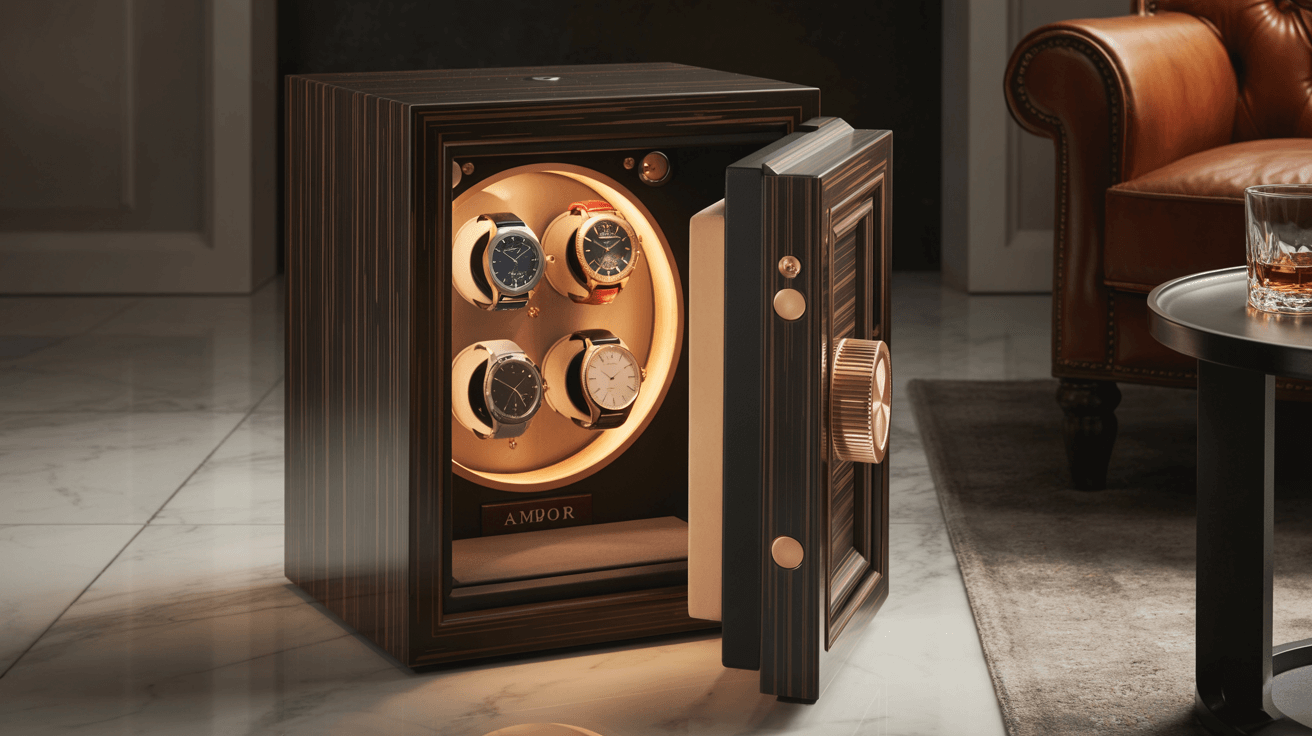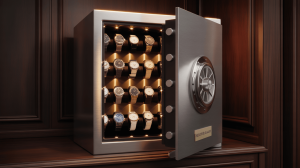custom watch winder safe vs Standard Holders: Which Suits Your Needs?. Here’s the deal… Choosing between a custom watch winder safe and standard holders affects security, functionality, and presentation. Let’s break down the differences so you can pick the perfect solution.
1. Automatic Watch Requirements
Automatic movements rely on regular motion to keep mainsprings tensioned. Left static, oils congeal and accuracy drifts. A dedicated winder offers programmable turns-per-day (TPD) and directional modes tailored to each caliber. Standard holders simply display watches but require manual winding or wear.
| Requirement | Winder Safe | Standard Holder |
|---|---|---|
| Mainspring Tension | Automated, adjustable TPD | Manual winding or wear |
| Lubricant Preservation | Continuous motion | Oil may stagnate |
| Accuracy Maintenance | Keeps time precisely | Risk of drift |
2. Custom Watch Winder Safe Overview
Custom winder safes blend vault-grade security with bespoke winding programs. You define capacity, finish, lock type, climate controls, and connectivity. Each module can be programmed for specific TPD, direction, and rest intervals, ensuring each watch’s specs are met. These safes also protect against burglary, fire, and humidity, making them an all-in-one solution for serious collectors.
3. Standard Watch Holder Overview
Standard holders range from acrylic display stands to foam-lined trays. They showcase watches neatly but offer no winding or climate control. Ideal for quartz or manually wound pieces, holders lack security features and leave automatics unwound overnight. They’re simple, affordable, and perfect for entry-level collections that prioritize display over preservation.
4. Security and Protection
Security varies widely. Custom safes use 12–14 ga steel, multi-bolt locks, and UL/ETL ratings. They bolt into studs or floors and include fireboard insulation. Standard holders open on a desk or shelf; theft or fire destroys the collection.
| Feature | Winder Safe | Standard Holder |
|---|---|---|
| Burglary Rating | UL RSC/ETL certified | None |
| Fire Resistance | UL 72 Class 350 (30–60 min) | None |
| Anchoring Options | Floor/wall bolt-through | Not applicable |
5. Winding Accuracy and Programmability
Custom winders let you set exact TPD (650–2,000) and rotation direction (CW, CCW, bi-directional). You can assign profiles per watch movement. Standard holders have no winding capability, so automatics stop after hours of inactivity, requiring manual resets for calendars and moonphases.
6. Capacity and Expandability
Custom safes start with 2–4 winding bays and scale to 10+ modules. Modular trays and drawers allow growth without replacing the unit. Standard holders come in fixed sizes—3- to 6-slot trays or stacks of single stands—offering limited expansion and no built-in security.
7. Aesthetic and Display Value
Custom safes offer glass fronts, LED lighting, and finishes like wood veneer or leather wrap—turning storage into décor. Standard holders prioritize simplicity: acrylic, wood, or foam that may clash with interiors.
| Display Aspect | Winder Safe | Standard Holder |
|---|---|---|
| Visibility | Gallery-style with illumination | Basic trays or stands |
| Material Finishes | Custom veneer, steel, leather | Plastic, wood, foam |
| Integration | Seamless furniture piece | Stand-alone accessory |
8. Build Quality and Materials
Custom safes use industrial-grade steel, quality welds, and premium exterior materials. Hinges, bolts, and locks are heavy-duty. Standard holders use injection-molded plastic or thin metal—adequate for display but prone to wear and easily damaged.
9. Noise and Vibration Performance
High-end winders feature rubber-damped mounts and precision motors under 25 dB, ensuring whisper-quiet operation. Standard holders produce no motor noise but offer no winding. Both remain silent, but only custom safes combine silence with automatic function.
10. Ease of Access and Use
Custom safes have electronic keypads, biometric locks, and time-delay options—balancing security and convenience. Interior drawers slide smoothly for selection. Standard holders allow instant access but no security; one lift reveals the entire collection.
| Access Method | Winder Safe | Standard Holder |
|---|---|---|
| Lock Type | Dial, keypad, biometric | None |
| Speed | Instant after unlock | Immediate |
| Convenience | App control, audit logs | Physically reach and lift |
11. Power and Backup Solutions
Custom safes run on AC adapters with rechargeable battery backups and low-battery alerts via app or LED. Standard holders require no power but don’t wind. If power fails, most custom safes allow manual override to access contents.
12. Climate Control and Dust Protection
Custom safes offer IP54 seals, desiccant chambers, or active dehumidifiers with digital hygrometers to maintain 40–50% RH. Standard holders leave watches exposed to dust and humidity fluctuations—risking strap damage and metal corrosion over time.
13. Smart Features and Connectivity
Connected safes push tamper, door-open, and power alerts to smartphones via Bluetooth or Wi-Fi. Remote winder scheduling and audit trails enhance oversight. Standard holders lack electronics and require no setup but offer no remote management.
| Smart Capability | Winder Safe | Standard Holder |
|---|---|---|
| Mobile Alerts | Yes | No |
| Remote Control | Yes | No |
| Access Logs | Yes | No |
14. Maintenance and Upkeep
Custom safes need periodic dusting, lock testing, battery and desiccant replacement, and motor checks. Standard holders only require occasional dusting. Both are low-maintenance, but only safes demand scheduled service to keep features working.
15. Cost and Value Proposition
Custom watch winder safes start around $1,000 and scale to $10,000+ based on materials, modules, and smart integration. Standard holders range from $20 to $200—affordable but limited. Invest in a custom safe for preservation, security, and presentation; choose holders for simple, budget display.
Conclusion
Custom watch winder safes deliver unmatched care through tailored winding, certified protection, and elegant display. Standard holders suit basic display needs but lack preservation features. Here’s the deal… match your collection’s value and your lifestyle to the option that safeguards your watches today and tomorrow.
FAQ
Q1: Can standard holders harm automatic watches?
Yes—without winding, automatics stop, oils stagnate, and accuracy suffers.
Q2: Do custom safes require professional installation?
Recommended for anchoring, especially for larger units.
Q3: Are custom safes energy-efficient?
Many use smart sleep modes and LED lighting to minimize power use.
Q4: Can I retrofit winders into my existing safe?
Some manufacturers offer compatible modules—verify before purchase.
Q5: Which is more cost-effective long term?
Custom safes have higher upfront costs but save on servicing and replacement winding.







